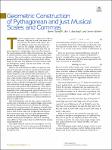Item Infomation
Full metadata record
| DC Field | Value | Language |
|---|---|---|
| dc.contributor.author | Børre, Nyhoff | - |
| dc.contributor.author | Alv I., Aarskog | - |
| dc.contributor.author | Sverre, Holm | - |
| dc.date.accessioned | 2023-04-06T07:17:10Z | - |
| dc.date.available | 2023-04-06T07:17:10Z | - |
| dc.date.issued | 2023 | - |
| dc.identifier.govdoc | https://link.springer.com/article/10.1007/s00283-022-10260-4 | - |
| dc.identifier.uri | https://dlib.phenikaa-uni.edu.vn/handle/PNK/7641 | - |
| dc.description | CC BY | vi |
| dc.description.abstract | To your average pianist, G-sharp and A-flat are the same. They are located at the same black key between the white G and A keys, but with different names. For other musicians, however, for example violinists, they are different notes. They would claim that the piano represents a compromise, since it is often tuned to the equal-tempered scale, while other musical scales, based on simple harmonic ratios, often appear more harmonious to the ear. This article explains and illustrates this dilemma geometrically. In these scales, G-sharp and A-flat will no longer be the same. The difference between them is called the Pythagorean comma, and the name hints at the long history of music theory. | vi |
| dc.language.iso | en | vi |
| dc.publisher | Springer | vi |
| dc.subject | G-sharp and A-flat | vi |
| dc.subject | Pythagorean comma | vi |
| dc.title | Geometric Construction of Pythagorean and Just Musical Scales and Commas | vi |
| dc.type | Book | vi |
| Appears in Collections | ||
| OER - Khoa học Tự nhiên | ||
Files in This Item:

